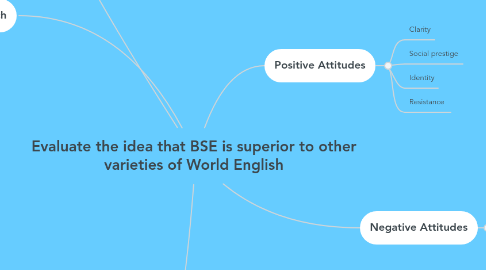
1. Codification
1.1. Education
1.1.1. 1800s - national school systems introduced where BSE is the preferred language form
1.2. Technology
2. Global Reach
2.1. 'Pure form' doesn't exist
2.1.1. For BSE to be superior there needs to be a 'perfect' form - language is constantly changing so this is impossible
2.2. Stolen/borrowed terms
2.3. Between 1.5 and 2 billion speakers
2.3.1. The population of Britain is only 60 million - most of these speakers aren't 'native' to Britain
2.4. American English
2.4.1. Indigenous language had little staying power
2.4.1.1. "The language of a conquered people has little effect on that of the conquerors" - Leith (2007)
2.4.2. Some American words have meanings or grammatical forms that once existed in UK English but which changed in one place and not the other.
2.4.2.1. E.g. 'Autumn' and 'Fall' - the latter was once used frequently in the UK.
2.5. Diasporas
2.5.1. First Diaspora
2.5.1.1. "Large-scale migrations of mother-tongue English speakers from England, Scotland and Ireland, predominantly to North America, Australia and New Zealand." (Jenkins 2005)
2.5.2. Second Diaspora
2.5.2.1. Colonisation led to the establishment of second-language varieties, called 'New Englishes'.
2.5.2.2. Singlish
3. English as a Lingua Franca (ELF)
3.1. Used between speakers who have no common language between them to enable communication for purposes such as trade.
3.2. Not a variety with specific features, but changes to suit the needs of its users at a given time.
3.3. Jennifer Jenkins (2006) - Five common characteristics of ELF:
3.3.1. 1. Provides a mutually intelligible language, used by speakers of different languages allowing them to communicate with one another.
3.3.2. 2. It is an alternative to English as a Foreign Language, rather than a replacement. Serves a functional communicative purpose rather than being associated with education.
3.3.3. 3. It is just as likely to include elements of Standard English as well as linguistic features reflective of more local forms.
3.3.4. 4. Accommodation and code-switching are common practice during LF communication.
3.3.5. 5. Language proficiency in speakers may be low or high.
3.4. Seidlhofer (2004) - typical ELF characteristics
4. Negative Attitudes
4.1. Towards non-standard forms
4.1.1. Incorrectness
4.1.1.1. Laziness
4.1.1.2. Lack of education
4.2. Towards standard forms
4.2.1. Colonialism
4.2.1.1. Loss of identity
4.2.1.1.1. Social/cultural/personal/ethnic
4.2.1.1.2. Hickey (2007) - "The fate of English has been closely linked with that of the Irish language which it came largely to replace in the late modern period."
4.2.1.2. Links to imperial rule
4.2.1.3. Slavery
4.2.1.3.1. "A population of little more than 2500 black slaves in 1700 had become 100,000 by 1775, far out-numbering the southern whites." (Crystal 2003)

